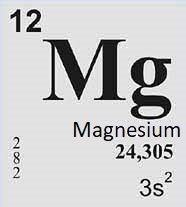Magnesium is a chemical element with the symbol Mg and atomic number 12. It is a silvery-white metal that belongs to the alkaline earth metals group in the periodic table.

Physical properties of magnesium
Here are some physical properties of magnesium:
- Appearance: Magnesium is a silvery-white, lightweight metal.
- Density: The density of magnesium is 1.74 grams per cubic centimeter (g/cm³), which is about two thirds that of aluminum.
- Melting and boiling points: Magnesium has a relatively low melting point of 650°C (1,202°F) and a boiling point of 1,090°C (1,994°F).
- Hardness: Magnesium is a relatively soft metal with a Mohs hardness of 2.5, meaning it can be scratched by harder materials.
- Ductility and malleability: Magnesium is highly ductile and malleable, which means it can be drawn into wires and rolled into thin sheets.
- Thermal conductivity: Magnesium has a high thermal conductivity, which makes it a good conductor of heat.
- Electrical conductivity: Magnesium is a good conductor of electricity, but not as good as copper or aluminum.
- Flammability: Magnesium is highly flammable and can ignite spontaneously in air. This makes it a potential fire hazard if not handled properly.
Overall, the physical properties of magnesium make it a useful metal in various industrial and scientific applications, such as in the production of lightweight alloys for use in aerospace and automotive industries.
Сhemical properties of magnesium
Here are some chemical properties of magnesium:
- Reactivity: Magnesium is a highly reactive metal that readily reacts with oxygen to form magnesium oxide. It also reacts with water to produce magnesium hydroxide and hydrogen gas. Magnesium is less reactive than alkali metals, but more reactive than most other alkaline earth metals.
- Oxidation state: Magnesium has an oxidation state of +2 in most of its compounds.
- Corrosion resistance: Magnesium is highly resistant to corrosion in dry environments, but it is prone to corrosion in moist environments and can even corrode in the presence of sweat from human skin.
- Reaction with acids: Magnesium reacts with most acids to produce hydrogen gas and magnesium salts. For example, when magnesium is added to hydrochloric acid, it produces magnesium chloride and hydrogen gas.
- Alloy formation: Magnesium forms alloys with many other metals, including aluminum, zinc, and copper. These alloys can have improved mechanical and physical properties compared to the pure metals.
- Combustibility: Magnesium is highly combustible and can ignite easily in air, making it useful in fireworks and other pyrotechnic applications.
Overall, the chemical properties of magnesium make it a versatile metal with a variety of industrial and scientific applications, such as in the production of magnesium alloys, as a reducing agent in metallurgy, and as a component in batteries and other electronic devices.
Magnesium isotopes
Magnesium has three stable isotopes: 24Mg, 25Mg, and 26Mg. These isotopes have atomic masses of 24.305, 25.306, and 26.305, respectively. The most abundant isotope of magnesium is 24Mg, which makes up about 79% of all magnesium on Earth. The other two stable isotopes, 25Mg and 26Mg, make up about 10% and 11% of magnesium, respectively.
In addition to the stable isotopes, magnesium has several radioactive isotopes, including 22Mg, 23Mg, 27Mg, 28Mg, 29Mg, and 30Mg. Of these, 28Mg is used in nuclear medicine for positron emission tomography (PET) imaging.
Magnesium isotopes can be used in scientific research to study processes such as chemical reactions and diffusion. They can also be used in geology to study the age and formation of rocks and minerals. Additionally, magnesium isotopes can provide information about the sources and transport of magnesium in biological systems.
Application of magnesium
Magnesium has many applications in various industries due to its unique physical and chemical properties. Here are some examples of its applications:
- Aerospace industry: Magnesium alloys are lightweight and strong, making them ideal for use in aircraft components, such as engine parts, landing gear, and structural components.
- Automotive industry: Magnesium alloys are also used in the automotive industry to reduce the weight of vehicles and improve fuel efficiency. Magnesium is used in engine blocks, transmission cases, and other structural components.
- Pyrotechnics: Magnesium powder is highly flammable and is used in pyrotechnics to produce bright, white light in fireworks and flares.
- Metallurgy: Magnesium is used as a reducing agent in the production of metals such as titanium, zirconium, and hafnium.
- Medical applications: Magnesium is used in medical applications, such as in antacids to neutralize stomach acid, in laxatives to relieve constipation, and in magnesium supplements to treat magnesium deficiency.
- Agriculture: Magnesium is an essential nutrient for plants and is often used as a fertilizer to improve crop yields.
- Electronics: Magnesium is used in electronics as a component in batteries and as a casing for electronic devices due to its lightweight and durable nature.
Overall, magnesium is a versatile metal with a wide range of applications in various industries.
